Diamond trading patterns, or diamond tops or bottoms, occur at the end of a prolonged trend. They are characterized by a widening and then narrowing price range, creating a shape similar to a diamond. These patterns provide traders with market reversal points in the financial markets.
Let’s discuss everything around diamond trading and how it can be used to trade the forex market.
What is a diamond trading pattern?
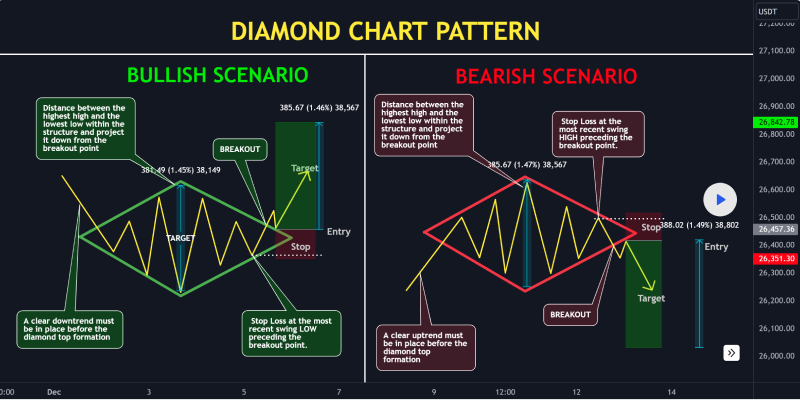
The diamond trading pattern is a technical analysis tool used to identify potential trend reversals in financial markets. The shape of the pattern is created by two converging trendlines: one connecting a series of lower highs and the other connecting a series of higher lows.
These trend lines converge towards a central point, signifying a potential shift in price momentum. There are two types of diamond patterns:
- Ascending diamond pattern: An ascending diamond emerges during a downtrend, with price bouncing between the trendlines. A breakout above the upper trendline suggests a potential shift towards an uptrend as purchasers gain control. It starts with an expanding price range, creating higher highs and higher lows, and then progresses to a narrowing price range, forming lower highs and higher lows.
- Descending diamond pattern: A descending diamond forms during an uptrend, with price action consolidating between the trendlines. A break below the lower trendline indicates a possible downtrend reversal as the number of traders exiting the trade increases. It starts with an expanding price range, creating lower lows and lower highs, and then progresses to a narrowing price range, forming higher lows and lower highs.
Identifying diamond trading patterns
Let’s take a look at the different charts and indicators that can help identify a diamond trading pattern:
Charts
Candlestick charts
Candlestick charts display price movements over a specific time period using candlestick shapes, with each candle indicating the open, high, low, and close prices. To spot a diamond trading pattern, look for:
- Upper trendline: This line connects a series of lower highs. Focus on the wicks (thin lines above/below the main body of the candle/bar) that represent the highest price reached during a trading period. The upper trendline should connect these peaks as they gradually decrease in height, forming a descending angle.
- Lower trendline: This line connects a series of higher lows. Focus on the real body (thicker part of the candle/bar) representing the closing price. The lower trendline should connect these closing prices as they gradually increase, forming an ascending angle.
- Convergence: The key aspect of a diamond pattern is the way these two trendlines (upper connecting lower highs, lower connecting higher lows) gradually come closer together, forming the diamond shape. The closer they converge towards a central point, the stronger the potential breakout signal.
Point and figure (P&F) charts
Point and Figure charts represent price movements using Xs and Os, focusing solely on price changes rather than time. They filter out noise and emphasize trends, making identifying support, resistance, and chart patterns easier. To identify the diamond pattern with this chart:
- Higher lows: Look for a series of Xs that create a sequence of higher lows. As the price makes higher lows, it will create a series of Xs stacked on each other, forming a rising trend (diagonal line of Xs).
- Lower highs: Locate a series of Os that create a sequence of lower highs. As the price makes lower highs, it will create a series of Os stacked below each other, forming a descending trend (diagonal line of Os).
- Convergence: Ensure these trendlines, formed by the stacked Xs and Os, converge towards a central point. This convergence making a diamond shape signifies a potential trend reversal.
Renko charts
Renko charts depict price movements using blocks or bricks of a predetermined size, disregarding the time factor. They highlight trends and filter out minor price fluctuations, providing a clearer visualization of price action and trend direction. Here's how to identify the diamond pattern with this chart:
- Higher lows: Look for a sequence of upward bricks that create a series of higher lows. As the price makes higher lows, it will be reflected in consecutive upwards bricks, forming a rising trendline.
- Lower highs: Find a series of downwards bricks that create a sequence of lower highs. As the price makes lower highs, it will be reflected in consecutive downward bricks, forming a descending trendline.
- Convergence: Ensure these brick-based trend lines converge towards a central point. This convergence, forming a diamond shape, suggests a potential breakout and trend reversal.
Indicators
RSI
The Relative Strength Index (RSI) measures the magnitude of recent price movements to gauge if a currency is overbought (above 70) or oversold (below 30). If the RSI stays range-bound within a diamond pattern, it suggests potential consolidation and indecision.
A breakout above the upper trendline accompanied by an RSI moving out of oversold territory (below 30 and rising) strengthens the bullish reversal signal. Conversely, a breakout below the lower trendline with RSI exiting overbought territory (above 70 and falling) reinforces the bearish reversal signal.
MACD
Moving Average Convergence Divergence (MACD) indicator measures momentum by comparing two exponential moving averages. The MACD line (difference between the averages) and a signal line (shorter-term average of the MACD) together show the direction and strength of momentum.
During a diamond pattern, a flat or slightly choppy MACD with the signal line close by suggests possible trend neutrality and potential for a breakout. A confirmed breakout above the upper trendline alongside a rising MACD line (indicating increasing bullish momentum) strengthens the bullish reversal signal. Conversely, a confirmed break below the lower trendline with a falling MACD line (indicating increasing bearish momentum) signals a bearish reversal.
CCI
The Commodity Channel Index (CCI) is an oscillator that measures the current price level relative to its average price over a specific period. Positive CCI values indicate the price is above the average, while negative values suggest it's below the average.
Like RSI, a CCI oscillating within a range during the diamond pattern formation suggests potential consolidation.
A breakout above the upper trendline supported by a rising CCI (indicating the price is moving further above the average) strengthens the bullish reversal signal. Conversely, a breakout below the lower trendline with a falling CCI (indicating the price is moving further below the average) reinforces the bearish reversal signal.
Step-by-step guide: how to spot diamond patterns
Identify the trend
Look at the overall price movement on the preferred chart (candlestick, bar, line, etc.) and confirm whether it is an ongoing uptrend or downtrend.
- If the price has been making a series of higher highs and higher lows over time, it suggests an ongoing uptrend.
- If the price has been making a series of lower highs and lower lows over time, it suggests an ongoing downtrend.
Look for trendline convergence
Draw a trendline connecting the lower highs if it's a downtrend or the higher lows if it's an uptrend. Then, draw another trendline connecting the remaining opposite highs/lows.
These trendlines should gradually converge towards a central point, forming a diamond shape.
Analyze the price action
Observe the price action within the diamond. The pattern should be relatively consolidated (bouncing between the trendlines) or showing signs of breakout attempts.
- Traders look for a flat or choppy price movement within the diamond when a diamond pattern indicates a period of consolidation. The price action gets somewhat restricted and bounces between the two converging trend lines that form the diamond shape. It suggests indecision in the market, with purchasers unable to gain dominance.
- A breakout in a diamond pattern occurs when the price decisively moves outside the established trend lines that form the diamond shape. In a downtrend, a breakthrough happens when the price closes above the upper trendline and vice versa.
Confirmation of breakout
A confirmed breakout occurs when the price closes above the upper trendline (bullish reversal) or below the lower trendline (bearish reversal).
False breakouts can happen, so wait for a clear and decisive close outside the trendlines for confirmation. This closure suggests a stronger price movement and a higher probability of a genuine trend shift.
Impact of external factors on the diamond trading pattern
Economic news releases
Major economic news releases or central bank policy decisions can cause significant price movements, potentially invalidating a diamond pattern breakout or creating false signals. For example, a strong positive economic report during a bullish diamond formation could trigger a premature breakout as investors rush to enter the trade, potentially overshadowing the intended bullish reversal signal.
Geopolitical events
Global events like political tensions or wars can trigger market volatility and disrupt established trends, making diamond patterns less reliable in predicting reversals. For example, a sudden outbreak of war during a bearish diamond formation could cause a temporary surge in less risky currencies, leading to a false breakout and potentially disrupting the anticipated downtrend.
Seasonal trends
Certain sectors or related currencies exhibit seasonal trends that can influence price movements and potentially overshadow diamond pattern signals. For example, a seasonal increase in demand for a commodity from Australia during a bearish diamond formation could create temporary price spikes in AUD, potentially misleading traders and weakening the bearish reversal signal.
Trading strategies using the Diamond trading pattern
Position sizing
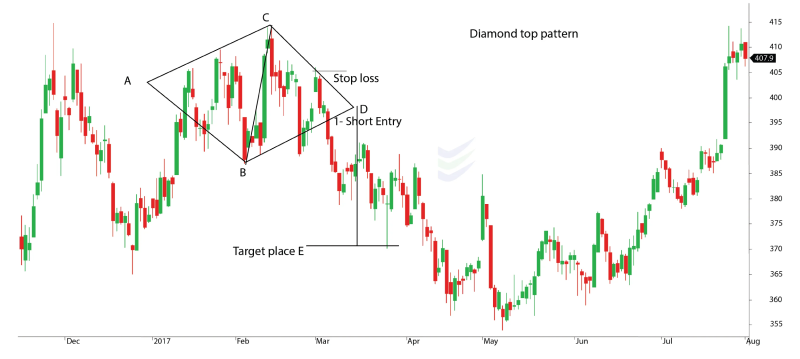
Positing sizing is a risk management strategy that enables traders to adjust the size of their trades based on their overall risk tolerance. In diamond trading, evaluate the diamond pattern's characteristics and look for tight convergence of trendlines, a strong prevailing trend, and confirmation from other indicators.
Determine the confidence level in the breakout signal. A stronger diamond pattern with strong confirmation inspires higher confidence. If confidence is high, allocate a larger portion of the capital to the trade. Conversely, a smaller position size can be used for less convincing diamond patterns.
Breakout strategy
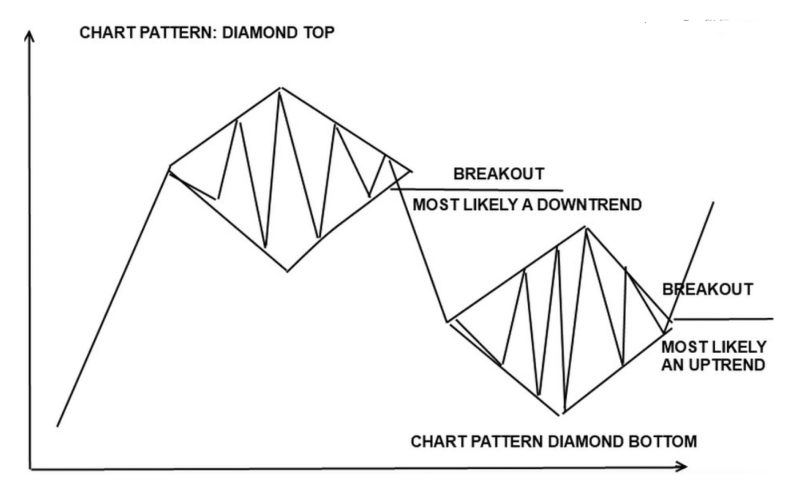
Breakout strategy involves trading the breakout from the diamond pattern, aiming to capture the price movement following the breakout. Wait for a confirmed breakout when the price closes above the upper trendline (bullish) or below the lower trendline (bearish).
Enter the trade after the confirmed close. It suggests a higher probability of a sustained trend shift. Place a stop-loss order just outside the opposite trendline of the breakout, limiting potential losses if the breakout is false.
Target projection strategy
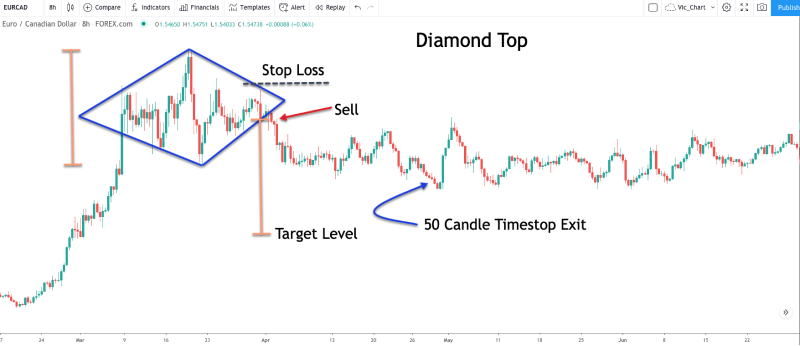
The target projection strategy aims to capitalize on the expected price movement after a confirmed breakout using measured target projections. Calculate the vertical distance between the upper and lower trendlines of the diamond pattern. It represents the potential price movement.
For a bullish breakout, add the measured distance to the breakout price. For a bearish breakout, subtract it. It provides an estimate of a potential target price, but actual price movements may vary.
Swing trading strategy
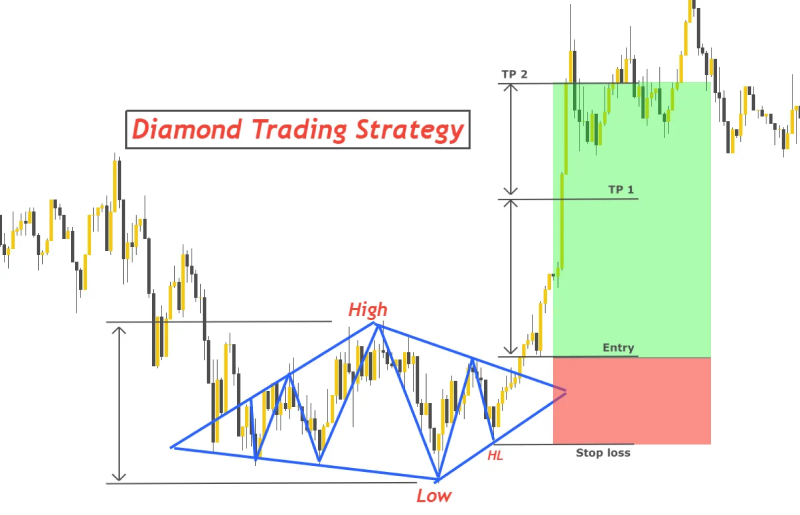
Swing trading strategy focuses on capturing larger price swings within the diamond pattern over a medium-term time frame. While trading a diamond pattern, look for a confirmation signal after the breakout, such as a moving average crossover, to support the trend direction.
Develop an exit plan based on risk tolerance and trading goals. Consider exiting when the trend shows signs of reversal or when a trader reaches their gain target based on technical indicators or other analysis methods.
Common risks with diamond trading patterns and how to avoid them
- False breakouts: Diamond patterns often lead to false breakouts, resulting in losses. Use confirmation indicators and wait for retests to verify breakout validity before entering trades.
- Ignoring broader market trends: Trading diamond patterns against the dominant market trend can result in losses. Conduct comprehensive trend analysis and ensure trades align with the overall market direction.
- Late entries: Entering trades late after the diamond pattern breakout can reduce gain possibility. Set alerts for breakout levels and be prepared to act when patterns are complete.
- Ignoring volume signals: Disregarding volume signals during diamond patterns can lead to missed breakout validations. Pay attention to volume spikes as confirmation for breakouts, ensuring stronger trade signals.
Incorporate the diamond trading pattern in forex trading
Diamond patterns signify potential trend reversals, with breakout trading being a common strategy. However, false breakouts and pattern misinterpretation pose significant risks. Combine thorough pattern analysis with confirmation indicators and strict risk management to navigate diamond pattern trading effectively and make informed decisions.
Disclaimer: All material published on our website is intended for informational purposes only and should not be considered personal advice or recommendation. As margin FX/CFDs are highly leveraged products, your gains and losses are magnified, and you could lose substantially more than your initial deposit. Investing in margin FX/CFDs does not give you any entitlements or rights to the underlying assets (e.g. the right to receive dividend payments). CFDs carry a high risk of investment loss.




